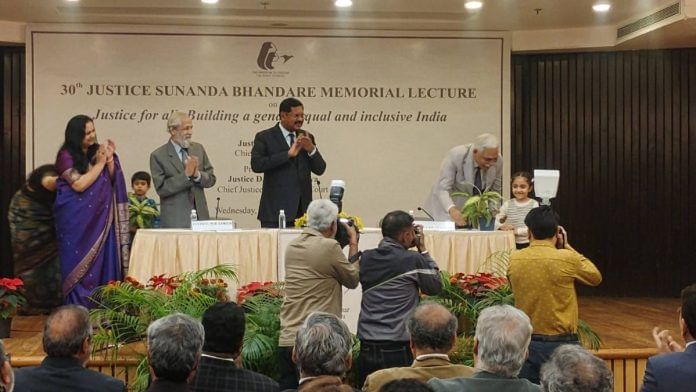New Delhi: Evolution of India’s judicial system notwithstanding, judicial interpretations have failed to capture the lived realities of women, Chief Justice of India B.R. Gavai made this big admission in Delhi recently before a gathering of lawyers and other attendees. Vigilance of civil society, the persistence of women’s movements and the courage of ordinary citizens have together kept the judiciary accountable.
Gavai was delivering the 30th Justice Sunanda Bhandare Memorial Lecture on ‘Justice for all: Building a Gender Equal and Inclusive India’ at the Multipurpose Hall of the India International Centre, Delhi. The lecture series commemorates Justice Sunanda Bhandare, an advocate and distinguished judge at the Delhi High Court.
The event started with a welcome for the guests with green plants by Justice Bhandare’s great-grandchildren. The 300-seat hall was filled to capacity in black and white, with people standing along the path to listen to the Chief Justice speak, at what would be one of his last public addresses before he demits office on 23 November. In attendance were Rajya Sabha MPs Anand Sharma and Praful Patel, Mukul Rohatgi, former Attorney General of India, among others from the legal fraternity, including young lawyers and students.
The event was hosted by Advocate Shreya Singhal of the Shreya Singhal Vs Union of India fame. The young audience erupted into cheers of approval when she thanked Justice Gavai for supporting young advocates by stopping the practice where senior advocates could pull rank and mention cases for urgent listing.
While CJI took the audience through the evolution of women’s rights in Indian law over the last 75 years, some young women lawyers/students Googled the number of women judges in the Supreme Court.
The sole woman judge of the Supreme Court, Justice BV Nagarathna, incidentally delivered the 28th lecture of the current series at the same venue in 2024.
Chief Justice of Delhi High Court DK Upadhyaya, the chair of the event, recalled that young lawyers called Justice Bhandare’s court ‘The Mother Bench’ as she listened, guided and corrected with care. He said that Justice Bhandare would have been delighted to see increasing representation of women in the legal profession, especially in district courts. Justice Bhandare made her mark as a judge in an era when women in courtrooms were still a rarity, more so as presiding officers of the court.
75 years in development
In the lecture, Justice Gavai noted three distinct phases of around 25 years each in the development — early years of national building, a period of social and judicial transformation, and finally the contemporary era where “equality and inclusion are being reemergent in the light of new challenges and aspirations”.
In the first phase, the framers of the Constitution were conscious of the deep-rooted social inequality and included powerful guarantees in the chapter of fundamental rights. Article 14 proclaims that every person is equal before the law.
The Chief Justice made special mention of the Special Marriage Act 1954, the Hindu Marriage Act 1955, and the Dowry Prohibition Act 1961. He also noted that issues affecting women, like polygamy, child marriages, were outlawed. Despite weak enforcement, these laws served as the basis for the future securement of women’s rights.
In the second phase, between 1975-2000, “the gender discourse moved towards a deeper idea of dignity as an inseparable component of equality”. The chief justice noted the Supreme Court judgment in Tukaram Vs State of Maharashtra, also known as the Mathura case. The Supreme Court acquitted two policemen accused of raping a young tribal girl inside a police station because there were no visible marks of physical resistance. “The judgement reflected deeply retrenched and patriarchal understanding of consent, effectively denying social context of power, coercion and vulnerability in which sexual violence occurs”. The chief justice called this “the most troubling moment in India’s constitutional and judicial history and a moment of institutional embarrassment”.
However, the public outrage and nationwide protests led by women’s groups, students and legal activists resulted in amendments to the criminal law that redefined consent in cases of custodial rape. As of today, there are special provisions in the penal code against rape committed under police custody, in hospital care or in jail.
Also read: 17 iconic Punjabis are now part of a new book by Ajeet Cour
Judicial evolution
In the last 25 years of our judicial evolution, judgments focused not just on violence and discrimination but gave women equal voice and opportunity in every sphere of life. Issues like workplace safety, representation, reproductive rights and equal pay came to the forefront.
Domestic violence now came to include physical, sexual, verbal, emotional and economic abuse.
The protections from domestic violence extended to sisters, mothers, women and live-in partners. The idea of gender equality also embraces queer rights and the inclusion of transgender persons. Reproductive autonomy was reaffirmed, and the Supreme Court held that the “right to reproductive choice is a part of personal liberty.”
Women get 26 weeks of maternity leave today instead of 12, for their first two surviving children. And adoptive and commissioning mothers also get 12 weeks’ leave.
The chief justice concluded by saying that “the march towards gender equality is not a destination reached but a commitment constantly renewed”.
Aditya GV is an alum of ThePrint School of Journalism.
(Edited by Saptak Datta)






